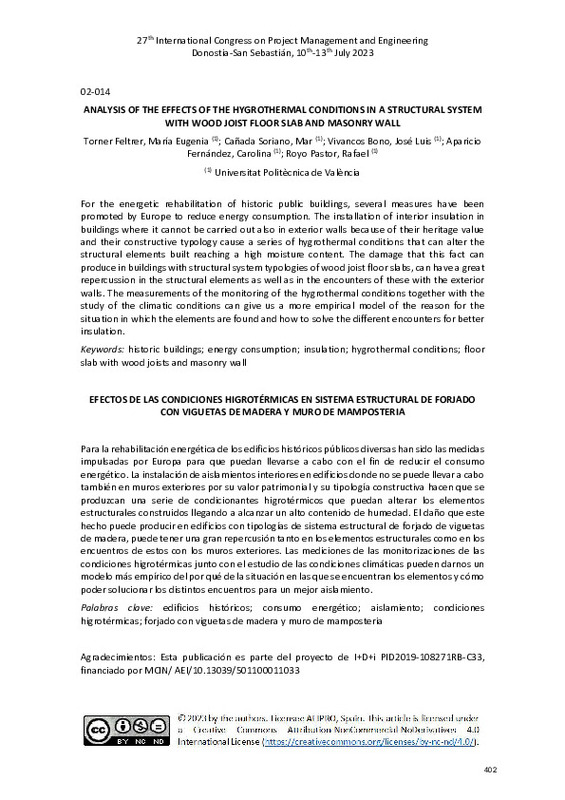JavaScript is disabled for your browser. Some features of this site may not work without it.
Buscar en RiuNet
Listar
Mi cuenta
Estadísticas
Ayuda RiuNet
Admin. UPV
Efecto de las Condiciones Higrotérmicas en Sistema Estructural de Forjado con Viguetas de Madera y Muro de Mampostería
Mostrar el registro sencillo del ítem
Ficheros en el ítem
| dc.contributor.author | Torner Feltrer, María Eugenia
|
es_ES |
| dc.contributor.author | Cañada Soriano, Mar
|
es_ES |
| dc.contributor.author | Vivancos, José-Luis
|
es_ES |
| dc.contributor.author | Aparicio Fernandez, Carolina Sabina
|
es_ES |
| dc.contributor.author | Royo, Rafael
|
es_ES |
| dc.date.accessioned | 2024-01-10T06:51:26Z | |
| dc.date.available | 2024-01-10T06:51:26Z | |
| dc.date.issued | 2023-07-13 | es_ES |
| dc.identifier.isbn | 978-84-09-55466-9 | es_ES |
| dc.identifier.uri | http://hdl.handle.net/10251/201673 | |
| dc.description.abstract | [ES] Para la rehabilitación energética de los edificios históricos públicos diversas han sido las medidas impulsadas por Europa para que puedan llevarse a cabo con el fin de reducir el consumo energético. La instalación de aislamientos interiores en edificios donde no se puede llevar a cabo también en muros exteriores por su valor patrimonial y su tipología constructiva hacen que se produzcan una serie de condicionantes higrotérmicos que puedan alterar los elementos estructurales construidos llegando a alcanzar un alto contenido de humedad. El daño que este hecho puede producir en edificios con tipologías de sistema estructural de forjado de viguetas de madera, puede tener una gran repercusión tanto en los elementos estructurales como en los encuentros de estos con los muros exteriores. Las mediciones de las monitorizaciones de las condiciones higrotérmicas junto con el estudio de las condiciones climáticas pueden darnos un modelo más empírico del por qué de la situación en las que se encuentran los elementos y cómo poder solucionar los distintos encuentros para un mejor aislamiento. | es_ES |
| dc.description.abstract | [EN] For the energetic rehabilitation of historic public buildings, several measures have been promoted by Europe to reduce energy consumption. The installation of interior insulation in buildings where it cannot be carried out also in exterior walls because of their heritage value and their constructive typology cause a series of hygrothermal conditions that can alter the structural elements built reaching a high moisture content. The damage that this fact can produce in buildings with structural system typologies of wood joist floor slabs, can have a great repercussion in the structural elements as well as in the encounters of these with the exterior walls. The measurements of the monitoring of the hygrothermal conditions together with the study of the climatic conditions can give us a more empirical model of the reason for the situation in which the elements are found and how to solve the different encounters for better insulation. | es_ES |
| dc.description.sponsorship | Esta publicación es parte del proyecto de I+D+i PID2019-108271RB-C33, financiado por MCIN/ AEI/10.13039/501100011033 | es_ES |
| dc.language | Español | es_ES |
| dc.language | Inglés | es_ES |
| dc.publisher | AEIPRO | es_ES |
| dc.relation.ispartof | Proceedings from the International Congress on Project Management and Engineering | es_ES |
| dc.rights | Reconocimiento - No comercial - Sin obra derivada (by-nc-nd) | es_ES |
| dc.subject | Historic buildings | es_ES |
| dc.subject | Energy consumption | es_ES |
| dc.subject | Insulation | es_ES |
| dc.subject | Hygrothermal conditions | es_ES |
| dc.subject | Floor slab with wood joists and masonry wall | es_ES |
| dc.subject | Edificios históricos | es_ES |
| dc.subject | Consumo energético | es_ES |
| dc.subject | Aislamiento | es_ES |
| dc.subject | Condiciones higrotérmicas | es_ES |
| dc.subject | Forjado con viguetas de madera y muro de mampostería | es_ES |
| dc.subject.classification | MECANICA DE LOS MEDIOS CONTINUOS Y TEORIA DE ESTRUCTURAS | es_ES |
| dc.subject.classification | MAQUINAS Y MOTORES TERMICOS | es_ES |
| dc.subject.classification | PROYECTOS DE INGENIERIA | es_ES |
| dc.subject.classification | CONSTRUCCIONES ARQUITECTONICAS | es_ES |
| dc.title | Efecto de las Condiciones Higrotérmicas en Sistema Estructural de Forjado con Viguetas de Madera y Muro de Mampostería | es_ES |
| dc.title.alternative | Analysis of the effects of the hygrothermal conditions in a structural system with wood joist floor slab and masonry wall | es_ES |
| dc.type | Comunicación en congreso | es_ES |
| dc.type | Capítulo de libro | es_ES |
| dc.identifier.doi | 10.61547/3372 | es_ES |
| dc.relation.projectID | info:eu-repo/grantAgreement/AEI/Plan Estatal de Investigación Científica y Técnica y de Innovación 2017-2020/PID2019-108271RB-C33/ES/NUEVAS METODOLOGIAS EN EL ANALISIS DEL CONFORT TERMICO Y LA EFICIENCIA ENERGETICA EN EDIFICIOS CON MODELOS 5D/ | es_ES |
| dc.rights.accessRights | Abierto | es_ES |
| dc.contributor.affiliation | Universitat Politècnica de València. Escuela Técnica Superior de Gestión en la Edificación - Escola Tècnica Superior de Gestió en l'Edificació | es_ES |
| dc.contributor.affiliation | Universitat Politècnica de València. Escuela Técnica Superior de Ingenieros Industriales - Escola Tècnica Superior d'Enginyers Industrials | es_ES |
| dc.description.bibliographicCitation | Torner Feltrer, ME.; Cañada Soriano, M.; Vivancos, J.; Aparicio Fernandez, CS.; Royo, R. (2023). Efecto de las Condiciones Higrotérmicas en Sistema Estructural de Forjado con Viguetas de Madera y Muro de Mampostería. AEIPRO. 402-412. https://doi.org/10.61547/3372 | es_ES |
| dc.description.accrualMethod | S | es_ES |
| dc.relation.conferencename | 27th International Congress on Project Management and Engineering (ICPME 2023) | es_ES |
| dc.relation.conferencedate | Julio 10-13,2023 | es_ES |
| dc.relation.conferenceplace | Donostia, San Sebastián | es_ES |
| dc.relation.publisherversion | https://doi.org/10.61547/3372 | es_ES |
| dc.description.upvformatpinicio | 402 | es_ES |
| dc.description.upvformatpfin | 412 | es_ES |
| dc.type.version | info:eu-repo/semantics/publishedVersion | es_ES |
| dc.relation.pasarela | S\506537 | es_ES |
| dc.contributor.funder | Agencia Estatal de Investigación | es_ES |








